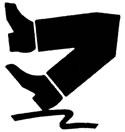 Second only to automobile accidents, falls are the leading cause of injury and deaths. Of these, accidents due to slipping or tripping form a large proportion. Slips and trips occur on floors, streets, walkways, stairs, etc. Although both slips and trips result in falls, they are otherwise quite different. A slip is associated with insufficient resistance between a foot and the walking surface, while a trip involves much more resistance than the victim had anticipated. A third type of fall results from a loss of balance. This can occur when one expects a surface to provide support, but it does not, such as while descending a staircase with an unanticipated long rise height step.
Second only to automobile accidents, falls are the leading cause of injury and deaths. Of these, accidents due to slipping or tripping form a large proportion. Slips and trips occur on floors, streets, walkways, stairs, etc. Although both slips and trips result in falls, they are otherwise quite different. A slip is associated with insufficient resistance between a foot and the walking surface, while a trip involves much more resistance than the victim had anticipated. A third type of fall results from a loss of balance. This can occur when one expects a surface to provide support, but it does not, such as while descending a staircase with an unanticipated long rise height step.
Expertise
We have a vast amount of experience in many aspects of fall downs including:
- Measuring friction coefficients of many walking surfaces
- Familiarity with building codes for stairway and ramp safety
- Analyzing the biomechanics of a fall to determine if it is consistent with the reported injuries
Questions Answered
Through scientific analysis, we can help you answer pertinent questions such as:
- Was the walkway too slippery?
- Did the slope of this walkway contribute to its slipperiness?
- Why were the steps hazardous?
- Why are falls more common coming down staircases than when climbing up them?
Case Examples
Exterior Staircase Fall Down:
After exiting a building, an elderly woman descended an outdoor, wooden, wide set of stairs. While doing so, she lost her balance, fell, and was seriously injured. Upon inspection, we determined that the rise height of the step where she fell was a half-inch higher than the previous steps. In addition, there was no handrail nearby. Both these items represented significant hazards and building code violations. The defendant settled the lawsuit after receiving our report.
City Park Fall Down:
A woman claimed that she had tripped on a walkway over a post protrusion at a city park and injured her eye socket. We performed a biomechanical simulation and video animation, which showed that a fall onto the flat walkway could not have caused her injuries, and that a witness, who saw her being blown against a park bench, offered a more consistent explanation. Consequently, a jury found that the city was not liable for her fall and injuries, as they could not control outdoor winds.
Kristopher J. Seluga, PE, is a Mechanical Engineering, Accident Reconstruction, Biomechanics, and Safety Expert with over 20 years of experience. He received his Bachelor's and Master's degrees from the Mechanical Engineering department at MIT where he worked on the development of novel three-dimensional printing technologies. Mr. Seluga is also a licensed Professional Engineer in New York and Connecticut, and has served as a member of the ANSI engineering committee for the Z130.1 and Z135 standards for golf cars and PTV's. His research interests and peer reviewed publications span the topics of Motor Vehicle Dynamics, Product Safety, and Biomechanics.
©Copyright - All Rights Reserved
DO NOT REPRODUCE WITHOUT WRITTEN PERMISSION BY AUTHOR.



 Second only to
Second only to 






